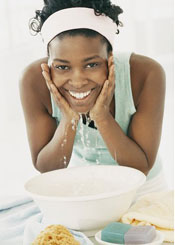A surprising number of skincare products are loaded with chemicals. Manufacturers use them for various reasons. Some of them are very cheap, which helps profitability. Others are used to extend shelf life and make the product “attractive” in terms of color and scent. Low price, durability, pleasant look and feel are attractive qualities. However, the ingredients creating these qualities can actually be harmful and damaging to your health.
Let’s see which chemicals often used in skincare products should be avoided. I’ve assembled a short list that contains the most troubling synthetics that should be avoided in your skincare purchases. Before you drop a personal care item into your shopping basket, take a closer look at the ingredient list of the product. If you see the following ingredients, don’t bother buying the product, however lovely it looks and smells.
Bigstock
Parabens. The paraben group contains various types, the mostly widely used ones of which are Methylparabens, Propylparabens, Ilsoparabens, Ethylparabens and Butylparabens. (Fortunately you only need to read this article, not read it out to someone!) They are widely used as preservatives in personal care products. Some scientific studies have found that parabens may be carcinogenic and may be linked to breast cancer. Although the matter has been recommended for further, large-scale scientific research before parabens are classified as toxic, in my opinion, it is best to err on the side of caution and avoid them. Unfortunately, parabens are found in many commercial products including shampoos, shower gels, cleansers, moisturizers, shaving gels, lubricants, tanning products, make-up and toothpaste, amongst others. Check what you buy and go for paraben-free products just to be on the safe side.
Phthalates. Phthalates are toxic substances that may damage the liver, lungs, kidneys and the reproductive system. They can be found in a wide range of products commonly used in every household. They are used in various personal care products too, including deodorants, perfume, aftershave, shampoos, hair products and lotions. Phthalates support the products’ absorption into the skin, help lubrication and serve as viscosity control and gelling agents, amongst others. If you see phthalates on the label of a personal care product, give serious consideration to not buy it. You may see the terms Diethyl Phthalate or DEP, Dibutyl Phthalate or DBP and Benzylbutyl Phthalate or BzBP on cosmetics, too.
Sodium Lauryl and Laureth Sulfate. Sodium Lauryl Sulfate (SLS) and Sodium Laureth Sulfate (SLES) are cleansing and foaming agents found in shampoos, body wash products and soaps, as well as general household detergents. They may cause skin and eye irritation, allergic reactions, inflammation, rashes and hair loss. Sometimes companies try to disguise their presence in their “natural” products with terms such “coconut oil” or “palm oil” or similar, due to the fact that SLS is derived from these oils. Still, they are known irritants and may be carcinogenic. SLS is known to be mutagen, which means that it may change DNA. It is thought to be particularly harmful for babies and infants as it may damage the development of their eyes and immune systems.
Diayolidinyl Urea and Imidayolidinyl Urea. These chemicals are widely used preservatives and are known to cause allergies and skin irritations. If you see either the above names or the commercial name “Germal” of this substance and its variations on a label of any skincare product, you should consider not buy it. You may find them in many personal care products including shampoos, bubble baths, hair conditioners, detergents and even in baby wipes.
Synthetic fragrances and artificial colors. Synthetic fragrances are petrochemicals that mimic natural aroma. Such fragrances tend to be stronger than what can be achieved when using only natural ingredients in a product. These are included in personal care products to stimulate the consumer’s senses and to have a psychological effect. The scent that make you think of a product as fresh and natural may be coming from a very unnatural source. The same is true to artificial colors. They are synthetic and their aim is to make a product attractive and visually appealing to the customer. They may however be carcinogenic. Fragrances may be created with many ingredients, which remain unlisted on skincare labels. If you see “fragrance” on a skincare label, it may mean basically anything. Synthetic colors may be labeled as FD&C or D&C, plus a number. Be cautious of both artificial fragrances and colors and go for fragrance and coloring-free natural alternatives. They may be white and scentless, but they will be good for you.
In addition, synthetics like Petrolatum in lip balms, Propylene Glycol in liquid foundations, sprays, mists and deodorants, lotions, shampoos, conditioners and lipsticks, PVP/VA Copolymer in hairsprays, Stearalkonium Chloride in creams and hair conditioners and Triethanolamine (TEA) in creams, ointments, hair products and shampoos should particularly be avoid. They are known irritants, allergens and may also be toxic.
If you see the above-mentioned synthetic ingredients or anything that is not listed here but looks and sounds like a chemical substance on the label of any personal care product, I would recommend that you consider not buying it. There are safer, natural and organic alternatives on the market. They may be pricier, do not smell like a meadow and do not have a vibrant color. However, they will be gentle on your skin and won’t allow toxins into your body.


